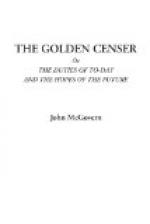he could earn three times as much money. The English penny is to-day a very large copper coin, being worth two cents, but in those times it weighed three times as much as to-day, as did all current coins. In addition to this great weight, money was very scarce, and fully six or seven times as valuable in many commodities as to-day. We will not err far in calling the laborer’s penny forty American cents. In 1350, then, the skilled laborer earned 3 pence in a day. He paid of his dear money, 1 shilling 10-1/2 pence for a bushel of wheat, and L1 4 shillings 6 pence for an ox. This means that he paid eight days’ (112 hours’) labor for his bushel of wheat, and 98 days’ (1372 hours’) labor for his ox. The ox would to-day rate far below a “scalawag” at the Stock Yards of Chicago or East St. Louis, weighing, perhaps, 400 pounds.
TWO HUNDRED YEARS LATER,
in 1550, the same kind of a laborer earned 4 pence in a day. He paid 1 shilling 10-1/2 pence for a bushel of wheat and L1 16 shillings 7 pence for an ox. This means that he paid nearly six days’ (about 80 hours’) labor for his bushel of wheat, and 110 days’ (1540 hours’) labor for his ox. The high price of the latter was justified by its great improvement in weight and quality.
IN THE FORTY-THIRD YEAR OF ELIZABETH
the coinage was lowered to about its present weight. In 1675, therefore, we see the laborer getting 7-1/2 pence for a day’s service. But he was compelled to pay 4 shillings 6 pence for a bushel of wheat, and L3 6 shillings for an ox. He thus was going backward, for temporary reasons, however, and had to pay seven days’ (98 hours’) labor for his bushel of wheat and 110 days’ (1540 hours’) labor for his ox. The ox had twice as much beef on him as the ox of 1350.
AND STILL FOR ANOTHER HUNDRED YEARS,
the march of the laborer upward was retarded by wars, famines, and “deaths,” as their plagues were called. In 1795, one of the darkest of those dark years, we find the skilled laborer receiving 1 shilling 5-1/4 pence per day (still of fourteen hours in winter, fifteen in summer). He paid 7 shillings 10 pence for a bushel of wheat and L16 8 shillings for an ox. This means that he paid five days’ (70 hours’) labor for his bushel of wheat and 119 days’ (1666 hours’) labor for his ox. The ox was what is technically called “a fair critter.”
TO-DAY THE SAME LABORER,
working ten hours a day—counting all the perquisites which have fallen to his lot,—the crumbs from the tables of his prosperous superiors,—the same laborer, I say, gets 3 shillings a day. He pays 6 shillings for a bushel of wheat and L12 for an ox. This means that he pays two days’ (twenty hours’) labor for his bushel of wheat and 80 days’ (800 hours’) labor for his ox. The ox rates better than a butchers’ “beast,” as the English say. In the meantime,




